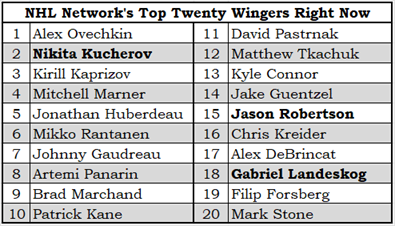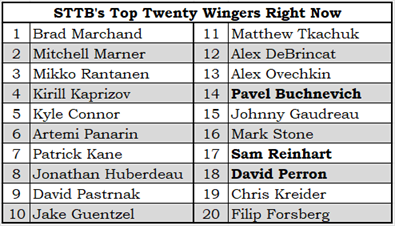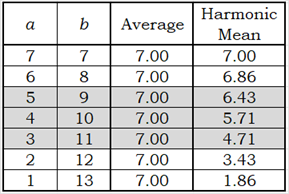On the morning of August 22, 2022, I saw a post on Reddit that said the NHL Network’s annual lists were coming out. It had a link to a tweet that showed their top twenty wingers.
I immediately wanted to compare that list, assembled by an unknown cadre of sports reporters in an unknown manner with unknown criteria, to the dispassionate numbers that Stapled To The Bench uses.
NHL Network’s Top Twenty Wingers
Here is the NHL Network list. As noted above, I have no idea who made the list nor how it was made. Were tea leaves read? Were ethically-sourced entrails examined?

The names in bold in the list above did not make it to the top-20 list compiled by Stapled To The Bench. Read on to see why they dropped off the list and with whom they were replaced.
Comments from the Twittersphere
The first comment I saw opined that ranking Patrick Kane 10th was wrong. It said, “Have they seen the sort of team Kane has to play for?”. It raises an interesting question: how do you rank a good player who is on a bad team?
Maple Leaf fans thought that Marner at #4 was so insultingly low that it curdled the milk in their double-double. Other tweets opined that Pastrnak and Robertson were ranked way too low, so there were also early comments from Boston and Dallas fans.
Comments by Stapled To The Bench
Gabriel Landeskog is a winger? He takes faceoffs 40% of the time. In the center rating article I wrote, any player who took faceoffs 20% of the time was considered a center.
Did they consider Matt Duchene to be a winger? He took faceoffs 42% of the time. How about Andrew Copp and his 44% taking-the-faceoff rate? Nathan MacKinnon took faceoffs less than half the time last season (49.7%): why isn’t he on the list of top wingers?
The Method to Their Madness
After playing with the STTB data for a while, I was able to create a rating system that resulted in the same top twenty players (but not in the same order). I used the harmonic mean (see Harmonic Mean of Two Numbers at the end of this article) of a player’s rank in Productivity Rating in 2021 and his rank in Productivity Rating per 82 games played based on the last three seasons.
Obviously, this is not how the NHL Network derived their list. They’ve never heard of Stapled To The Bench for starters, the order of players on the two lists is wildly different, and they almost certainly don’t know what a harmonic mean is.
The NHL Network used the phrase “right now” in the title of its list, and that is absolutely the approach they took. The players on their list have been some combination of very good over the last three seasons and very good last season. Most of the players were in both categories.
Top Twenty Wingers Right Now, According to Stapled To The Bench
To me, this was a question of future value rather than previous productivity. What twenty players will be the best wingers in 2022/2023? Fortunately, there is a rating system which is very suitable to use to answer this question: Value Rating (VR).
I also used my definition of a winger: a player who takes less than 20% of the faceoffs. The twenty wingers with the highest Value Rating in the 2021/2022 season are shown below.

Players Dropped from the NHL Networks List
Landeskog was dropped from my list because he is a center, according to my definitions.
Kucherov was dropped because he didn’t play a regular season game in the 2020/2021 season, and only played 47 games last season. Part of a player’s value is his ability to play games, and this is reflected in the VR formula: injuries reduce a player’s value.
Jason Robertson was dropped because he only played three games in 2019/2020, so that counts as a season played in the Value Rating formula. That makes it look like he missed a lot of games that season, when in reality he played 60 games for the Texas Stars and only three for the Dallas Stars. While Kucherov’s value was reduced due to injury, Robertson’s value was reduced due to Dallas keeping him in the minors for most of the 2019 season.
Players Added to the STTB List
VR-Score is based on a player’s PR-Score from his previous three seasons. The players added to the STTB list have had very good seasons in their previous three years.
Pavel Buchnevich’s last three seasons have been PR-First5, PR-Star and PR-Star.
Sam Reinhart has had five straight PR-First5 seasons.
David Perron last three seasons have been PR-First5, PR-Star and PR-First5. They were three of his four best seasons: his VR-Rating has been rising every season since 2015/2016.
Knockin’ on Heaven’s Door
The gap between the 20th best winger and the 21st best winger was very slight. I thought it would be appropriate to mention those players who almost made the top 20.
William Nylander, Nikolaj Ehlers, Connor Brown, Evander Kane and Kevin Fiala ranked 21st through 25th.
Summary
At this time, when anything you say can be retained online forever, it is a nervy thing to make predictions. One player could have a bad season and people would focus on that one player when evaluating your list. Prognostication is not a job for frail people.
Personally, I don’t agree with all the players on the NHL Networks list, and I absolutely don’t agree with their order of those players, but every hockey fan in the planet would be in the same boat. I think I understand their logic for having selected their twenty players, and they adhered to that logic very well.
While I found it interesting that the STTB data could be manipulated in such a way that the two lists had a degree of concordance (same top twenty), I am not a fan of manipulating data in that way. I’d rather look at the data to see what it has to say, rather than twist the data so that it says something. The latter approach sounds a little bit like torture.
Harmonic Mean of Two Numbers
The harmonic mean of two numbers reflects both their average and their proximity to each other. If the two numbers are the same, then the harmonic mean is the average. If the two numbers are different, the harmonic mean will be lower than the average. The farther apart the two numbers are, the closer the harmonic mean will be to the lowest number.
The formula for the harmonic mean of two numbers (a and b) is:

Below is a table which shows the average and harmonic mean for several different pairs of numbers. Notice that the average is always 7.

